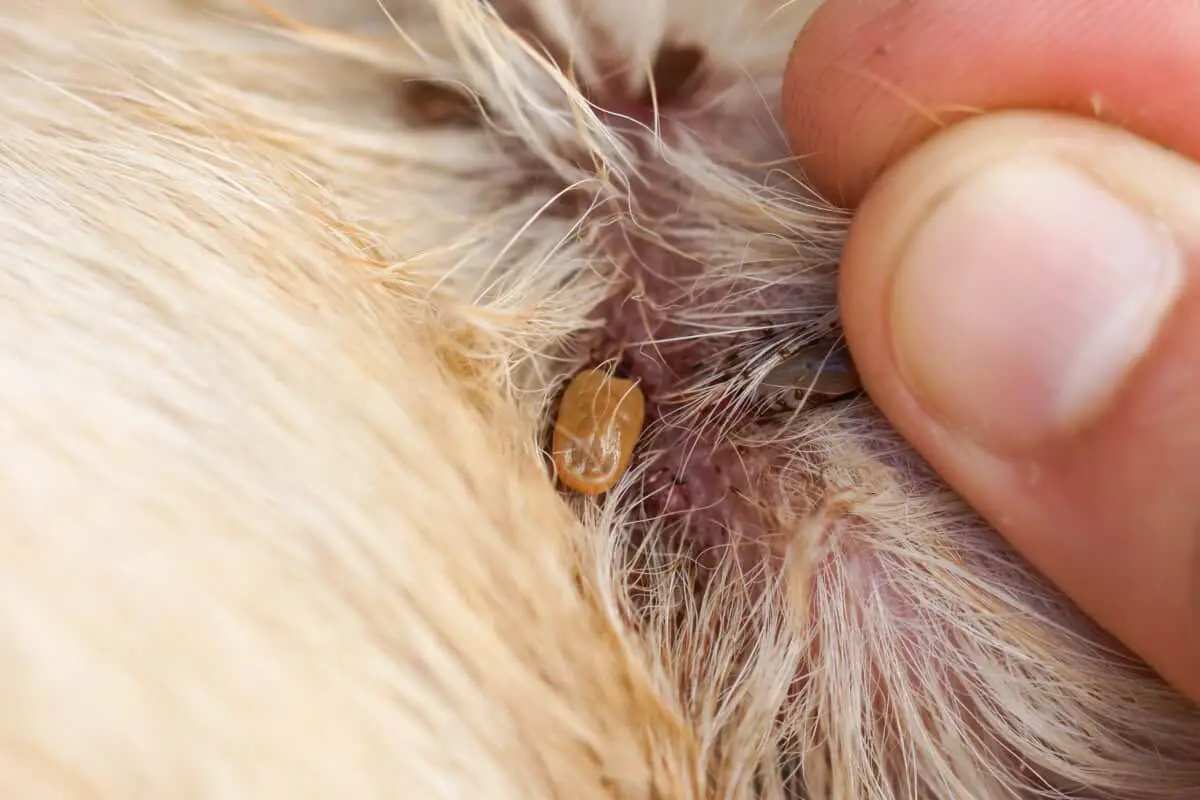Affiliate Disclosure: This post may contain affiliate links. If you make a purchase after clicking on these links I will be compensated at no extra cost to you. However, I never recommend anything I don’t love or wouldn’t use myself!
Some people have little dogs that they mainly keep inside, while others may have big dogs that love being outdoors. Whatever type of lifestyle your best friend has, ticks can become a big problem if you don’t take the necessary precautions.
There are two main ways that dogs get ticks. The first is when dogs brush past ticks that lie in wait among long grass and foliage outdoors. The second is when ticks are inadvertently brought into the dog’s home by humans or other animals.
These are the main ways dogs get ticks. However, there are more risks that you should be aware of. Keep reading to learn more about these nasty little parasites and how to protect your dog from them.
What Are Ticks?
It is important to understand exactly what ticks are. Knowing what they do, and what they look like will help you better protect your pets.
Ticks are parasitic arachnids that are closely related to mites and spiders. They bury their heads into the skin of their host and their oval-shaped bodies swell up as they suck the host’s blood for several days or more.
The age, gender, and fullness of a tick affect the size of its body. Adult ticks have eight legs and are normally about three to five millimeters in length. The juvenile ticks (known as larvae and nymphs) are smaller and only have six legs until they mature.
Ticks, like mosquitos, leave itchy and painful spots behind on the skin after they are done feeding. Also, like mosquitos, ticks can transfer diseases when traveling between hosts.
Ticks are most well known for spreading Lyme disease, but they can also transfer Rocky Mountain Spotted Fever, Typhus, and many others, depending on location.
How Your Dog Gets Ticks
Dogs can pick up ticks from almost anywhere. Whether your dog is in a wooded area with lots of undergrowth, amongst some tall grass, at the dog park, in your backyard, or even inside your home, ticks can be present.
While ticks are typically spread around by other animals and even humans, they are not spread like fleas that jump from one host to another as they cannot jump in the same way.
Instead, ticks like to climb in grass and undergrowth, favoring heights of around 18 to 24 inches off the ground. Here they simply wait around for potential hosts to pass by. This is known as “questing.”

When an opportunity presents itself they will climb aboard a host such as your dog and then make their way to warmer, hidden areas such as the ears, armpits, groin, or toes and then latch on.
Once hitched onto a host, they begin feeding until they are fully engorged at which point, they will drop off again to move to the next stage of their lifecycle.
For those in their juvenile larva or nymph states, this means malting and then beginning to “quest” once again to find a new host.
Various animals or sometimes birds might travel through your backyard. Engorged ticks can then fall off of these animals to lay their eggs or malt. These newly malted or hatched ticks can then find their way onto your dog as it passes by.
Another contributor to dogs getting ticks is people. If you or other people in your household are outdoorsy types, you might find that you are the ones that are giving your dog ticks! While ticks do attach themselves to humans, they can also get transferred from your clothing, bags, or shoes.
If you live in an area with a known tick population and you go outside a lot, check yourself for ticks before entering your home or interacting with your dog.
Do Ticks Lay Eggs on Dogs?
Ticks do not lay eggs directly on dogs. Once egg-laying female adults are engorged, they must detach themselves from their host to start reproduction. They usually lay their eggs in soft undergrowth like leafy brush but may lay them indoors on furniture, carpeting, or clothes.
So while fully grown adults will detach from their host to mate or lay eggs, that does not mean that your dog is safe from their offspring. If a tick lays her eggs in your home or your backyard, it can cause a bad infestation and can lead to your dog having many more.
How to Prevent Ticks on Your Dog
This section applies to every dog, whether they get ticks frequently, or have never had ticks before. If you live in an area with a high tick population, or if your dog rarely goes into areas favored by ticks.
No matter the situation, it is a good idea to take measures to prevent ticks on your dog. They are a problem that you don’t want to deal with. As with most things in life, prevention is better than cure.
Use a Spot-On Medication
Spot-on medications are known for being very effective, more so than anti-tick shampoos. A spot-on medication will kill any current ticks on your dog and will also keep ticks from wanting to jump onto your dog in the first place.
Most spot-on tick treatments will also protect against fleas so you are killing two birds with one stone. There are all sorts of medications, sprays, collars, and shampoos that you can put on your dog to prevent ticks and fleas but spot-on treatments are my go-to prevention.
My favorite brand is Frontline (Amazon) and I strongly recommend it. Having dealt with fleas and ticks on more than one occasion in the past, the money I spend on spot-on treatments for my 3 dogs (and cat) is definitely worth the peace of mind.
Treat Your Property
If you’re in a particularly bad area for ticks, you can also take the precaution of treating your yard and the edges of your home.
You can use various anti-pest sprays to repel ticks or kill them. Another effective method is just trimming your bushes and lawn back so that ticks are less likely to use the foliage to lay eggs or go questing in.
There are also flea and tick sprays designed for use around the home.
Manually Check for Ticks
The cheapest way of making sure your dog does not have ticks is to check them by hand frequently and thoroughly.
Admittedly, this is not such a preventative measure, but if you don’t want to spend any money, or you just don’t like the idea of using chemicals on your dog or around your property, then it’s a valid one.
It takes around 36 to 48 hours for a tick to transmit Lyme disease so if you want to be on the safe side, you should check your dog daily, particularly in tick season if your dog spends a lot of time outside.
Watch for ticks and tick eggs around your yard and home also.
Identifying Ticks on Your Dog
We’ll go over the basics on how to detect ticks on your dog by hand. However, there are also other tell-tale signs that your dog may have ticks such as changes in its behavior and demeanor.
I strongly encourage you to take a look at this in-depth guide that goes into detail on the various signs to look out for.
To find ticks manually, run your hands and fingers through your dog’s coat feeling for any lumps or bumps.
If you find any, look closer to verify that it is a tick. They are little black, brown, or tan bugs with 6-8 legs depending upon their life stage.
Ticks favor places such as the ears, eyelids, armpits, groin, between the toes, and around the tail. Each of these places should be checked thoroughly and frequently.
How to Treat Ticks
Now that you know where the ticks are, if there are any, you need to remove them as soon as possible, and they need to be removed properly.
If you are using tweezers, grab the tick as close to the skin as you can without pinching your dog. Tweezers that have narrow tips are better as you do not want to squeeze or rupture the abdomen of the tick. When using a tick remover, follow the instructions on the product.
Once you have gripped onto the head of the tick, pull it out slowly, in a straight line, and in one movement to prevent infection.
It is important to avoid any jerking motions. This could cause the head to detach, and then toxins could be injected into your dog. Leaving the head in could also cause an infection in the area, and it can be very difficult to get the head out of the skin afterward.
The following video is a good demonstration of how to remove a tick properly.
Aftercare
Once the tick has been removed, place it in a jar with isopropyl alcohol so if your dog begins to show symptoms of tick infection, your vet can properly identify what kind of tick it was. This will help them administer the best medication to your dog.
Next, take care to wash your hands thoroughly. Clean your dog’s wound with an antiseptic to prevent infection and irritation. Also, take care to clean your tweezers with isopropyl alcohol so that there are no remaining bacteria on them. If the skin in the area stays irritated or an infection breaks out, take your dog to the vet to have it checked out.

